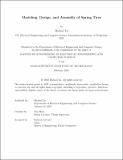Modeling, Design, and Assembly of Spring Tires
Author(s)
Lu, Michael
DownloadThesis PDF (57.42Mb)
Advisor
Hom, Gim
Terms of use
Metadata
Show full item recordAbstract
With a renewed interest in the Moon and the need for autonomous lunar rovers that drive longer distances and operate over extended durations, designing efficient and robust mobility systems is paramount. Created by NASA Glenn Research Center, the spring tire is a compliant airless tire engineered for planetary rover missions in lunar and Martian environments. It consists of hundreds of coiled springs woven together to create a toroidal-shaped mesh wheel that can deform to uneven terrain, providing additional durability and traction. This work aims to apply this technology to two robotic testbeds: ERNEST, an autonomous lunar traversal rover built at NASA Jet Propulsion Laboratory, and IPEx, a lunar regolith mining robot built at Kennedy Space Center. This thesis discusses the modeling of these spring tires with numerical methods along with the design of two spring tire prototypes for use on the aforementioned rover platforms. A streamlined assembly process for these compliant wheels is also outlined as well as the results of compression testing, rough terrain driving, and drawbar pull testing to assess their performance.
Date issued
2025-02Department
Massachusetts Institute of Technology. Department of Electrical Engineering and Computer SciencePublisher
Massachusetts Institute of Technology